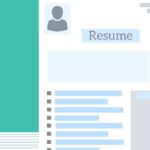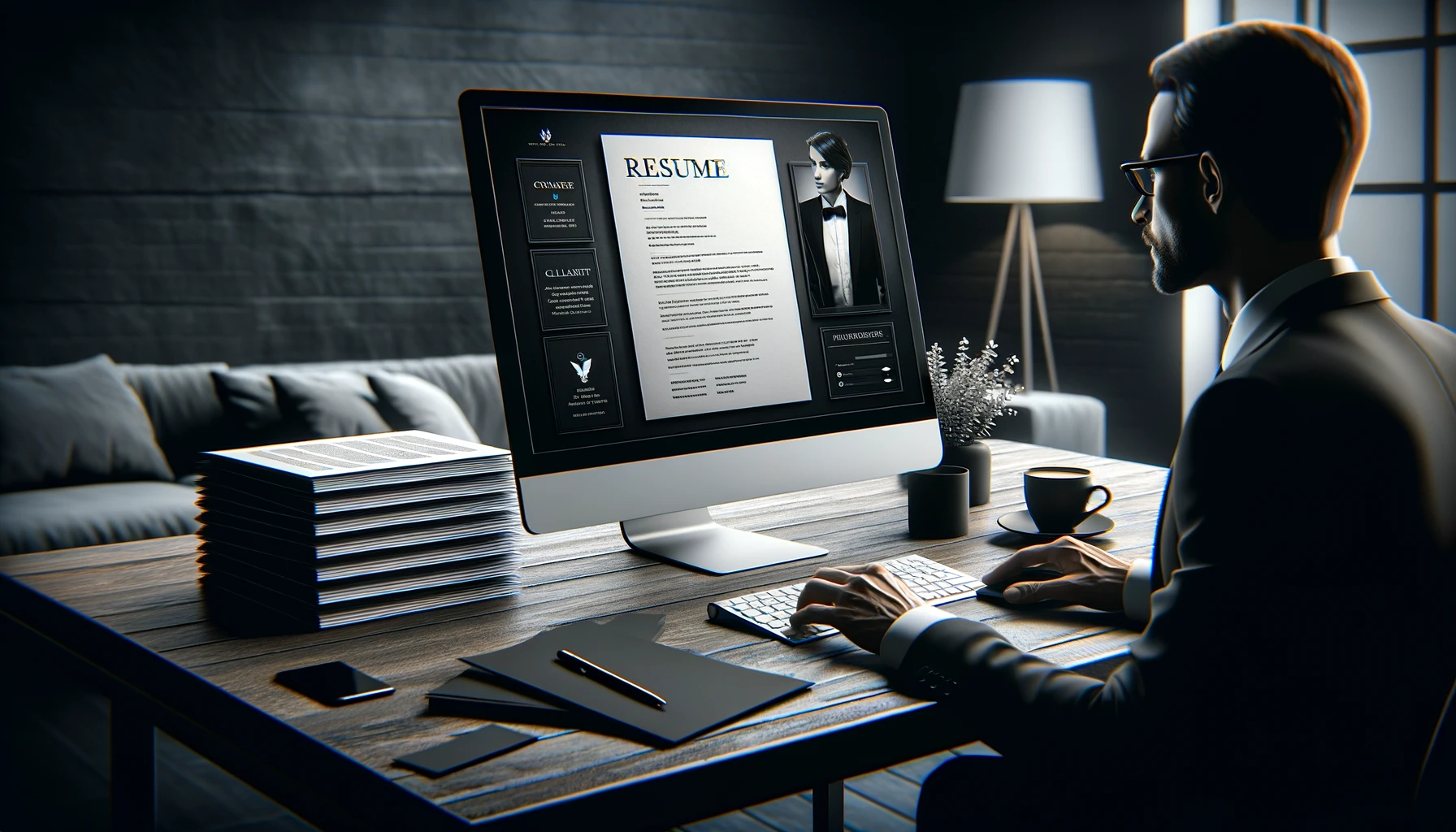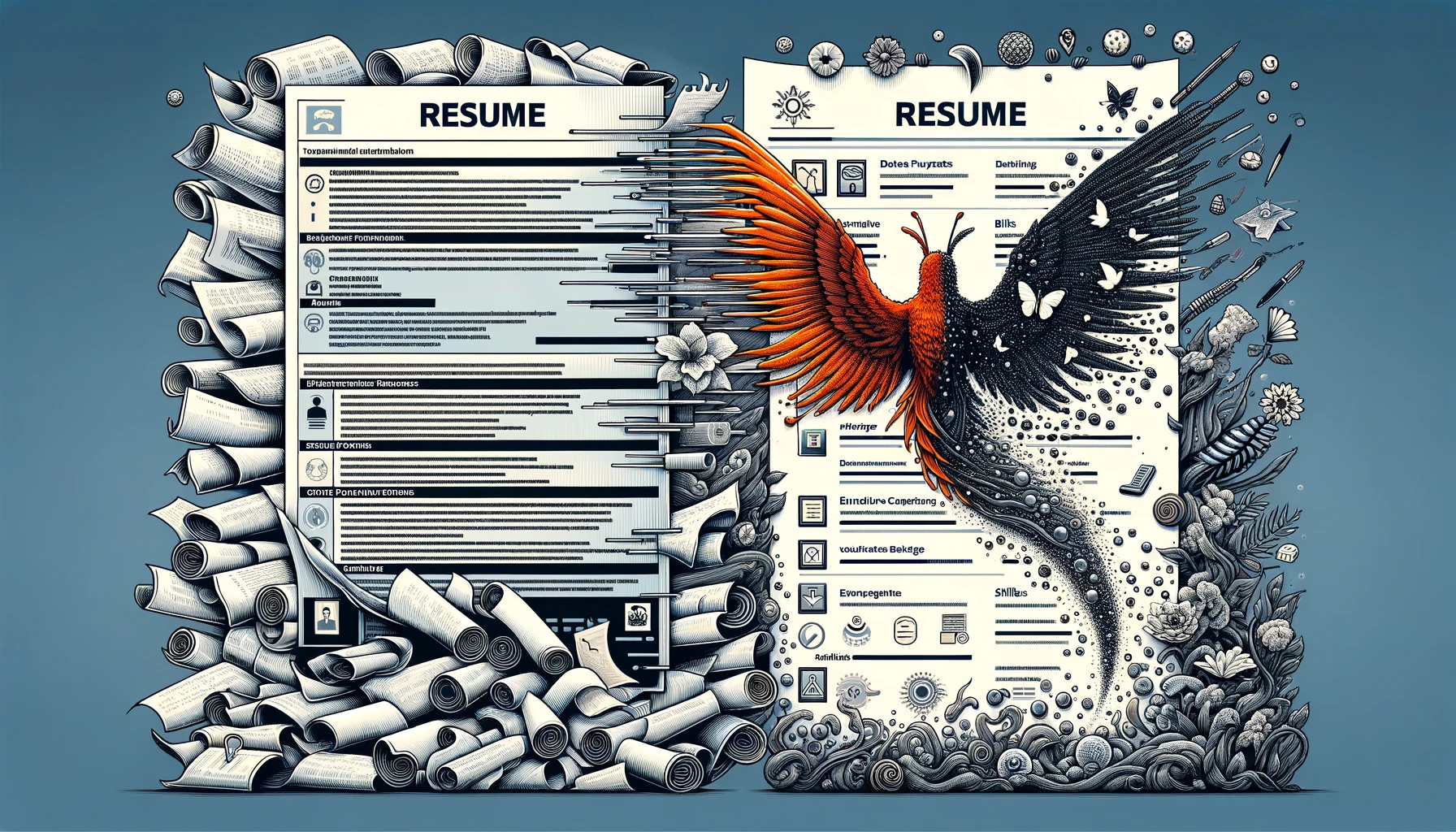Mastering resume design is a crucial step in your job search journey.
Crafting a resume is not merely an exercise in writing; it’s also an essential device to showcase your abilities and skills.
But let’s be honest here…
Nailing the perfect resume design can feel like trying to hit a moving target, especially with ever-changing trends and employer preferences.
You might have spent countless hours tweaking fonts or adjusting margins only to wonder if you’re making any real progress.
We get it!
This process can seem daunting but remember…
The key lies in listing your skills and experiences and presenting them so recruiters cannot ignore them.
Table Of Contents:
- Unlocking the Power of Resume Design
- Decoding the Spectrum of Resume Designs
- Three Key Considerations for Your Resume Design
- Mastering Resume Design Techniques
- Integrating Social Media Into Your Resume
- How Personal Websites Amplify Your Job Search
- Free Resume Templates And Tools: A Job Seeker’s Ally
- FAQs in Relation to Resume Design
- Conclusion
Unlocking the Power of Resume Design
The design of your resume isn’t just about aesthetics. A well-crafted resume can be a powerful asset in your job search, helping to draw the eye of recruiters and showcase your qualifications.
1. Harnessing the Potential of Resume Templates
When it comes to crafting an eye-catching resume, templates are a game-changer. They offer predefined layouts and formats, allowing you to focus on highlighting what matters most: your qualifications.
Professional resume templates, for instance, not only bring consistency but also elevate the visual appeal of your document – setting it apart from other candidates’ submissions.
2. Mastering Layouts and Formats in Your Favor
Beyond its visual aspect, how information is arranged within a resume—the layout—can be instrumental in conveying critical details quickly.
A cluttered or confusing format may deter recruiters, while clear sections make scanning easier for busy professionals.
This importance extends beyond first impressions; effective layouts ensure key points aren’t overlooked during brief reviews by human resources staff or applicant tracking systems (ATS).
3. Standing Out with Strategic Design Choices
Differentiating yourself among countless applications can be challenging, but using thoughtful design choices could give you an edge over the competition—even if you’re not applying for creative roles.
- Leverage unique designs: If you’re working in fields like graphic design where creativity is valued highly, showcasing this through innovative designs becomes crucial.
- Maintain professional standards: Even non-creative professions should consider breaking away from traditional formats slightly to create visually engaging resumes without compromising professionalism.
Decoding the Spectrum of Resume Designs
Differentiating yourself from a pool of job applicants can be challenging, but an aptly chosen resume design is your secret weapon.
From traditional to creative and modern styles, each type speaks volumes about you before employers even read a single word.
A Deep Dive into Traditional Resume Designs
Sticking to classic formatting principles works best in more formal sectors such as finance or law. A professional resume, typically sporting clean lines with black and white color schemes, gives it that simple yet sophisticated look.
Serif fonts are commonly used in these designs due to their readability on print materials – essential for industries still relying heavily on paper-based applications.
Corporate resumes fall under this category, too, prioritizing clarity over creativity; after all, they’re not just documents but mirrors reflecting one’s professional journey.
The Artistry Behind Creative Resumes
Moving onto roles where creativity is key – think graphic design or advertising agencies – having a creative resume template helps distinguish you from others.
These often use infographic elements, turning them into highly visual communication tools rather than plain text-based summaries.
Bright colors and bold headers instantly draw attention while showcasing unique personality traits alongside skills and experience.
Here’s how: Innovative approaches like adding infographics make data easier to digest while simultaneously proving your out-of-the-box thinking abilities.
Unpacking Modern Resumes
On the other end of the spectrum lie modern resumes popular among tech-savvy professionals working in fields such as IT or digital marketing.
Modern resumes, known for minimalist aesthetics with ample white space interspersed strategically with pops of color, give off an ultra-clean vibe aligning perfectly well within dynamic workplaces where less indeed means more.
The typography leans towards sans-serif fonts, ensuring seamless readability across multiple devices – crucial given today’s remote work culture demands flexibility beyond office cubicles.
Key Takeaway: Think of your resume design as a megaphone for your professional self. If you aim for formal sectors like finance or law, go traditional. Use black-and-white color schemes and serif fonts to show sophistication. But if you’re targeting graphic design or advertising roles, let creativity shine through with infographics and bold colors – it shows innovative thinking. For a modern vibe, opt for minimalist aesthetics coupled with sans-serif typography.
Three Key Considerations for Your Resume Design
The job of constructing a resume that is compatible with your professional objectives and grabs the attention of recruiters may appear intimidating.
But, by focusing on these three crucial aspects, you can create a standout resume without breaking a sweat.
1. Balance Text and White Space
A well-designed resume is like an art piece where content plays the role of color strokes while white space acts as the canvas.
Too much information clutters your ‘canvas’, making it hard to decipher; too little makes it look empty or unfinished.
To strike this balance in your design, consider text density and distribution throughout different sections – experience, skills, education, etc.
A balanced layout looks aesthetically pleasing and ensures readability for hiring managers scanning through piles of resumes. Here’s some advice on creating killer resumes.
2. Tailor Your Resume For Each Job Application
You’re unique – so why shouldn’t your resume be? While a base template is useful, tweaking details to match each job will ensure your resume stands out.
Highlight relevant experiences or skills that resonate with what employers are seeking in their job descriptions.
Tailoring doesn’t mean rewriting everything from scratch. It’s about adjusting the focus based on what would most appeal to potential employers’ needs and expectations. Here are examples across various fields.
3. Draw Inspiration From Successful Resumes In Your Field
In addition to balancing elements within your own document and tailoring its contents per application, another strategy involves studying successful samples from others in similar roles or industries.
This isn’t about copying exactly but rather understanding how they’ve effectively structured their data so you can adapt those principles into something uniquely yours.
Key Takeaway: Creating a top-notch resume design is no rocket science. Just remember to balance your text and white space for readability, customize it according to each job application highlighting relevant skills or experiences, and take cues from successful resumes in your field. It’s not about cloning but learning from the best.
Mastering Resume Design Techniques
The success of your resume hinges on a delicate balance between content and white space. This doesn’t imply vast areas left blank but rather an intentional design strategy that keeps the reader’s attention by preventing overcrowding.
Apart from content arrangement, typography choices can make or break perceptions about you. The clean, professional look achieved with simple fonts like Arial or Calibri is hard to beat.
But if sophistication is what you’re after, serif fonts such as Times New Roman or Georgia could be just the thing for headers and subheaders.
If brevity without sacrificing crucial information sounds appealing, consider using a one-page resume format coupled with a two-column layout. It optimizes available space while maintaining an organized flow of details.
The Role Of Color And Graphics In Resume Design
Color schemes are often double-edged swords; too many bright colors might come off as unprofessional, whereas no color at all may appear dull.
A middle-ground solution would involve subtle color elements interspersed throughout your document – perhaps in headings or borders around certain sections.
Incorporating a colored sidebar adds visual interest without overpowering page content. Dark blue has been found particularly effective due to its professionalism and readability against white backgrounds.
Bold Headers And Bullet Points: Boosting Readability
Clear section headlines and bullet points significantly improve resume readability by presenting information in digestible bits, which aids quick scanning by hiring managers dealing with multiple applications daily.
Fiddling around with font sizes and margins also affects the overall appearance considerably; larger fonts draw attention, while smaller ones work well for less critical details like hobbies or references.
As always, striking a balance here is key, so ensure ample white space remains after these adjustments have been made.
Key Takeaway: Achieving the perfect resume design is a balancing act. It involves the strategic use of white space to avoid clutter, thoughtful typography choices for professionalism and readability, and an organized layout that presents information succinctly. Incorporating subtle color elements can enhance visual appeal without appearing unprofessional, while clear section headlines and bullet points boost readability. Remember: it’s all about balance.
Integrating Social Media Into Your Resume
Your online presence can be a game-changer in defining your personal brand. Incorporating social media profiles into your resume can add an extra edge to impress potential employers.
Picking the Right Profiles
Social media outlets are not all the same when it comes to projecting a professional image. LinkedIn is a clear choice for showcasing career achievements and networking with industry professionals.
If creativity defines your work field, Instagram or Behance may be fitting to demonstrate your talent.
Remember, every platform you include should align with the professional image you want to project. Steer clear of including personal accounts that don’t contribute positively towards this image.
The Power of SEO on Social Media
To boost visibility, consider implementing an SEO strategy across these profiles. Where possible, weave keywords relevant to your profession and skill set within descriptions and posts.
A well-executed social media SEO strategy will enhance search engine rankings of the profile itself and any associated content shared through these channels, making it easier for a recruiter or a hiring manager to find you online.
Tailoring Your Resume: The Key To Success
Customization is crucial in resume design; one size does not fit all jobs or industries.
Tailor each application by highlighting unique experiences pertinent to the position at hand and integrating corresponding social media links where applicable, whether on an inspiring or simple resume.
This approach helps create a cohesive narrative about who you are as a professional while providing evidence supporting claims made within the resume.
Consistency ensures harmony between what’s written on paper (or PDF) and what’s displayed digitally. While incorporating social media into resumes might seem daunting initially due to its evolving nature and varying employer expectations, don’t let fear hold back progress.
By taking time now to understand how best to integrate such elements strategically, you will ultimately lead to greater opportunities down the line.
You can potentially achieve your desired outcome by leveraging the resources available to you. It might just turn that dream job from a distant wish into a reality you love daily.
Key Takeaway: Consider your resume as your personal billboard and social media as the loudspeaker. Highlighting fitting profiles, such as LinkedIn for professional connections or Instagram for creative gigs, can tip the scales in your favor. But don’t overlook SEO optimization of these platforms to ramp up visibility. Customize each application with pertinent experiences and matching social links – it’s all about crafting a cohesive professional story. Embrace the digital world without fear.
How Personal Websites Amplify Your Job Search
The modern job search isn’t just about the traditional resume anymore. It’s a whole new ball game where personal websites are stepping into the spotlight. So, how do these online platforms complement your resume? Let’s delve deeper.
“A well-crafted personal website can be a game-changer in today’s competitive job market. It not only highlights your skills and achievements but also provides employers with an immersive experience of who you are as a professional.”
In essence, having an online presence through a personal website gives potential employers firsthand insight into what you bring to their team.
A Showcase for Skills Beyond Resumes
Your abilities go beyond bullet points on paper—your personal website is proof of that. For instance, if you’re adept at graphic design or software development, displaying examples of your work directly speaks volumes more than any resume ever could.
- You can showcase tangible evidence of past work that cannot be presented on paper alone.
- Creative professionals get an open canvas to display their competencies and accomplishments effectively.
- You hold control over your narrative—how it unfolds depends entirely upon how creatively you leverage this platform.
Making Yourself Visible: SEO Keywords Matter
SEO keywords ensure prospective employers find you during targeted searches when used strategically in the site content and meta descriptions.
The key here lies in understanding which terms recruiters might use while searching for candidates with specific skill sets—and incorporating those seamlessly within your site’s content.
After all, being easily discoverable by recruiters significantly increases the chances of landing interviews.
“Being easily discoverable by recruiters increases chances of landing interviews significantly.”
Key Takeaway: Shake up your job hunt by entering the digital age with a personal website. This online platform amplifies your resume, giving employers an immersive glimpse of you as a professional. Showcase skills that don’t fit on paper and control your narrative in style. And remember, smart use of SEO keywords can make you a beacon for recruiters.
Free Resume Templates And Tools: A Job Seeker’s Ally
The pursuit of the perfect job begins with an impressive resume. It’s your professional story, elegantly penned and creatively presented.
Wondering if you should commence from the beginning or hire an expert for this job? The answer is neither. A free resume template available online is here to make things easier.
A free Resume Template, for instance, offers professionally designed layouts ready to use by any job seeker. They cater to various roles across industries – whether you’re into something minimalist or more creative, they’ve got it covered.
Picking Your Perfect Template
Choosing the right template isn’t just about aesthetics; industry norms and role specifics matter, too. But remember – content reigns supreme in every design choice made.
Select designs that highlight skills without being overshadowed by the style itself. Clean lines and clear sections are always safe bets, allowing recruiters to scan through information without distractions quickly.
Personalizing Your Resume
Taking customization up a notch, consider adding unique elements like company-specific color schemes or trending fonts while always ensuring readability. Remember, though, less is often more when it comes to keeping things professional.
Bullet points can help break down work experiences and achievements into digestible bits, making reading a smoother process for recruiters and hiring managers alike.
Tailoring details towards the specific job description is also key in highlighting relevant skills and experiences needed for the position applied for.
Leveraging Online Tools To Their Fullest Potential
Beyond sample resumes, platforms like Resume.io provide comprehensive resume-maker tools and guides to help craft a standout document that the competition will envy.
These resources range from tips on writing an effective summary section to crafting an impactful cover letter, alongside numerous examples and inspiration provided within their extensive library accessible via this link: A Resume Template as PDF or Word files.
Key Takeaway: Chasing the perfect job? A standout resume is your ticket. There is no need to start from scratch or hire a pro; free online templates cover you. Choose designs that showcase skills without overshadowing them with style. Add unique elements for personalization, but remember – less is more. Use bullet points for easy reading and tailor details to match the job description.
FAQs in Relation to Resume Design
What is the best design for a resume?
The ideal resume design depends on your industry and job role. Traditional designs work well for formal industries, while creative resumes are suitable for artistic roles. Modern styles are perfect for tech-savvy fields.
How do I design my own resume?
To design your resume or cover letter, choose a template that aligns with your career goals. Customize it to highlight your skills and experiences. Ensure readability by using clear headlines, bullet points, and maintaining a balanced white space.
What is the best resume design for 2023?
In 2023, simple yet bold designs are trending. Opt for clean layouts with subtle color accents to make an impactful impression on hiring managers.
How far back should a resume go?
A typical rule of thumb suggests going back 10-15 years in employment history, unless earlier experience directly relates to the position you’re applying for.
Conclusion
Optimizing your resume layout can be an invaluable asset in the job hunt, as it showcases your accomplishments and skills in a manner tailored to specific industries.
A well-designed resume isn’t just about aesthetics; it’s a strategic tool to highlight your skills and achievements.
Different designs cater to different industries, ensuring that you stand out for the right reasons.
Whether traditional or modern, creative or minimalist, there’s a perfect style waiting for you.
The art of balancing text with white space is key to creating an eye-catching layout that grabs attention.
Social media integration and personal websites offer additional platforms to showcase your unique brand.
Tailoring resumes for each application can give you an edge in today’s competitive market.





